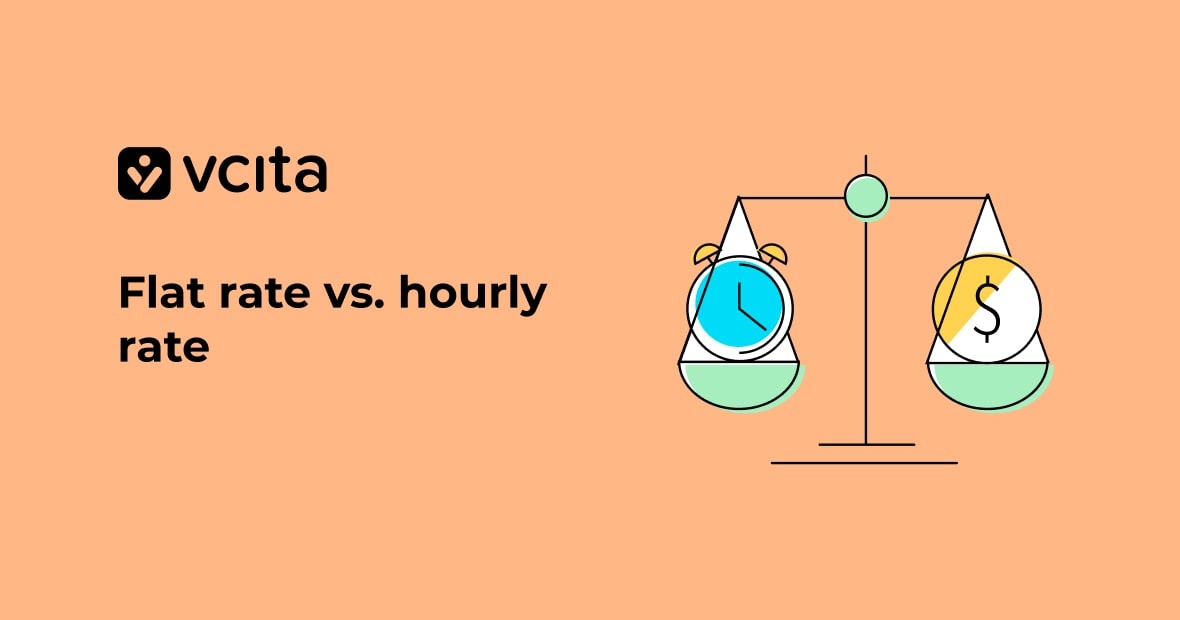Deciding on your billing method can be a real headache for every small business owner. It usually comes down to two main alternatives: do you charge clients by the hour or opt for a flat rate?
There’s no simple answer to this question. You have to weigh up the pros and cons of each billing method. In principle, flat rates simplify your billing process, but you risk undercharging for your time. With hourly billing, the amount of work directly correlates to the amount you get paid, but it makes it hard to predict income.
Let’s break down both billing methods so you can decide what’s best for your business.
Understanding the differences between flat rate and hourly billing
Both billing methods have their pros and cons, so you’ll want to consider which works best for your particular business.
Flat rate pricing provides predictable income
With a flat rate pay system, you charge a single fixed price for a service, no matter the amount of work or number of hours involved. This means you get paid the same amount whether the work takes 10 hours or 50 hours. It provides predictable income and cash flow since you know exactly how much you’ll make for each project. It also allows you to quote flat fees to clients upfront so they know what to expect.
Hourly billing is simpler but less predictable
An hourly rate pay system is straightforward but less predictable. You charge an hourly wage for the actual time spent on a task. So if a task takes 20 hours to complete, the client pays for 20 hours. If it only takes 5 hours, they only pay for 5 hours. However, it can be difficult to estimate the total cost for a client upfront, so quoting an accurate price is challenging. It also means your earning potential is limited by the number of hours in a day.
The pros and cons of hourly billing vs flat rates for service providers
For small service businesses, choosing between hourly or flat rate billing is an important decision that impacts your revenue and client relationships.
The pros and cons of hourly billing
Hourly billing is a straightforward system that’s easy to understand for both you and your clients. You get paid for every hour of work, so the more time you put in, the higher your revenue. Hourly billing also reduces the risk of undercharging for complex jobs.
However, there are some downsides. Billing by the hour can lead to disputes over the amount of time spent on a task. Clients may suspect that you dragged out work to increase your hours rather than focusing on efficiency, which can damage client relationships.
It also provides no cost certainty for the client, as the total bill depends on how long the project takes. This unpredictability can make some clients hesitant to hire your services.
The time spent creating invoices, tracking hours, and managing billing eats into the time you can spend working and generating revenue.
The benefits and disadvantages of flat rate pricing
A flat rate pay system means charging a single fixed fee for a service, regardless of the amount of work or time required. Your customers won’t worry that you’ll be tempted to spend unnecessary time on the project, which improves customer trust.
From your side of things, you know that you’ll get paid the same amount even if you’re highly efficient and complete the work in a shorter period of time.
It’s far simpler to produce invoices when you have flat rates, and you can easily provide clients with estimated total costs before you start your work.
On the other hand, your clients may feel overcharged if you work very quickly and the job takes less time than they expected. It’s also more challenging to estimate rates that will adequately cover your costs and time for more complex projects.
Overall, while hourly billing is a straightforward system, it may not be the best choice if you want to provide transparency and predictability to clients. For some types of work, a flat rate pay system where you charge a flat fee for a project may be preferable. This provides cost certainty for the client upfront, while allowing you to focus on completing the work as efficiently as possible. Consider your services, clients, and business goals to determine if hourly or flat rate billing is right for you.
Tips for choosing the best billing method for your business
In the end, the billing method you choose should make financial sense for your business while keeping your clients happy. Evaluate both flat rate and hourly billing objectively before determining what works best for your small business. Here are some of the main issues to consider.
Estimate the amount of work and time required
The most important factor to consider is how much work is required for each project or service you provide. If the amount of work and time is consistent for most clients, a flat fee may make the billing process simpler. However, if the amount of time and work varies significantly between clients, it may make more sense to charge based on the actual number of hours involved.
Think about your clients preferences
Think about what your clients typically prefer and expect. Some clients may feel like they get better value from a flat rate, knowing exactly what they’ll pay upfront. Other clients may prefer an hourly rate, feeling they have more control and transparency over costs. Choose a billing method that aligns with your clients’ needs and expectations.
Evaluate what’s right for your services
For services where the amount of time and work involved is consistent, a flat rate system usually works well, like for standard website designs, bookkeeping, or tutoring sessions. For more variable services, an hourly rate may be better since the total cost will depend on the number of hours required. Consulting, IT support, and freelance writing fall into this category.
Weigh up the pros and cons of each method
Both flat rate and hourly billing have their advantages and disadvantages. With a flat rate, you have a predictable income and simpler billing, but you risk undercharging if a project takes longer than expected. An hourly rate provides flexibility and transparency, but can lead to uncertainty in your income and billing. Consider what’s most important for your business model and growth.
Make changes as needed
Don’t feel locked into the billing method you choose initially. As your business grows and develops, you may find one method is no longer the best fit. Many businesses start with an hourly rate to keep things simple, then move to value-based or flat rate pricing as they become more established. The billing method that works for you today may evolve over the lifetime of your business.
Consider a hybrid model
You don’t have to choose one method over the other. Many businesses find success with a hybrid model, charging flat rates for some services and hourly fees for others. You might also charge flat project fees but with an hourly cap to limit the total cost for the client. The key is finding the right balance between predictable income and fair pricing for the work you do.
Finding the right balance
As a small business owner, you need to determine what combination of flat rate and hourly billing works for your unique business model and target clients. Think about the types of services you offer, your client’s needs and budget, and your own work preferences. Don’t be afraid to experiment to find the approach that maximizes your earning potential while keeping clients happy. With the right billing method, you’ll build a sustainable business that benefits both you and your customers.





